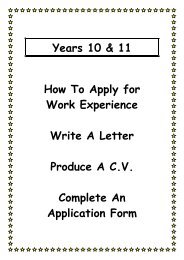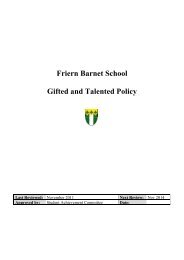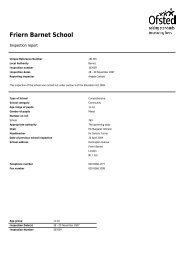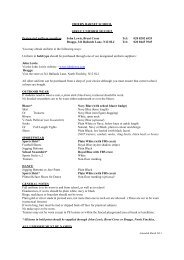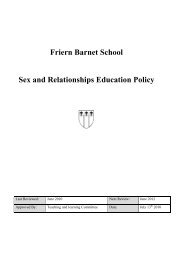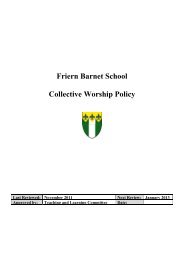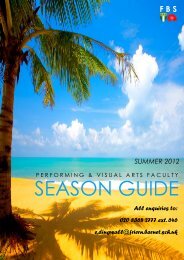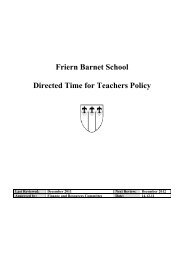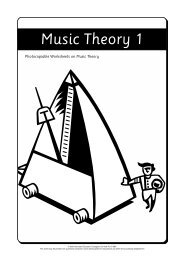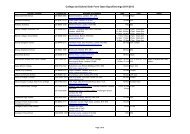VOL 166 Music Theory 2 - Friern Barnet School
VOL 166 Music Theory 2 - Friern Barnet School
VOL 166 Music Theory 2 - Friern Barnet School
Create successful ePaper yourself
Turn your PDF publications into a flip-book with our unique Google optimized e-Paper software.
Name: ____________________ <strong>Music</strong> <strong>Theory</strong> 2 Worksheet<br />
WRITING FOR PERCUSSION<br />
The percussion section of the orchestra is one of the most varied with a vast range of instruments<br />
to choose from. Percussion instruments fall into two categories tuned and untuned. Tuned<br />
percussion instruments are capable of producing a pitched note whilst untuned percussion<br />
instruments produce an effect rather than an identifiable pitch.<br />
The main percussion instrument found in the orchestra is the timpani or kettle drums. These<br />
are usually played in groups of two or three and each drum has a range of around a fifth. The<br />
tuning for timpani is usually stated at the beginning of a piece of music and you can use a key<br />
signature if you wish. If you need the drums to change pitch during a piece then the Italian phrase<br />
muta, meaning for change, is written followed by the note it is changing from and the new note<br />
required (e.g. muta A in B ).<br />
Timpani parts are written in bass clef. If you want to show a drum roll then it is written rather<br />
like an extended trill above the note you want it to affect.<br />
1555p55555p555<br />
xmmmmmmmm<br />
1555p55555p555<br />
or occasionally<br />
(<br />
(<br />
The vibraphone sounds at the pitch it is written, whilst the xylophone sounds an octave higher<br />
and the glockenspiel two octaves higher than written. All are written in treble clef. The tubular<br />
bells are also written in treble clef.<br />
Untuned percussion parts are usually written on a single line although you can use a five line<br />
stave if using several instruments and give each one a particular line. When writing for snare<br />
drum if you don’t wish the player to use the snare the marking is without snares, scordato or<br />
senza corda. If writing cymbal there are two main technical terms to remember. Laisser vibrer<br />
is the first which means that the cymbal should be left to vibrate until the sound has died away<br />
and sec is the second which means that the sound should be cut off. Both terms are French.<br />
!@£$%^&*()_<br />
There are also many visual signs that are used to indicate change of beater or effect as above.<br />
Obviously using a different beater will affect the sound the instrument produces and percussion<br />
instruments are quite flexible in this way.<br />
www.keynoteseducation.com © 2004 Keynotes Education Crossgate Cornwall PL15 9SX<br />
This sheet may be printed from a personal computer and/or photocopied for educational use within the purchasing establishment<br />
32




